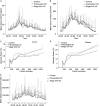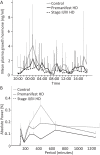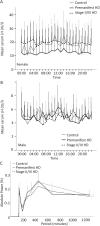A 24-Hour Study of the Hypothalamo-Pituitary Axes in Huntington's Disease
- PMID: 26431314
- PMCID: PMC4592185
- DOI: 10.1371/journal.pone.0138848
A 24-Hour Study of the Hypothalamo-Pituitary Axes in Huntington's Disease
Abstract
Background: Huntington's disease is an inherited neurodegenerative disorder characterised by motor, cognitive and psychiatric disturbances. Patients exhibit other symptoms including sleep and mood disturbances, muscle atrophy and weight loss which may be linked to hypothalamic pathology and dysfunction of hypothalamo-pituitary axes.
Methods: We studied neuroendocrine profiles of corticotropic, somatotropic and gonadotropic hypothalamo-pituitary axes hormones over a 24-hour period in controlled environment in 15 healthy controls, 14 premanifest and 13 stage II/III Huntington's disease subjects. We also quantified fasting levels of vasopressin, oestradiol, testosterone, dehydroepiandrosterone sulphate, thyroid stimulating hormone, free triiodothyronine, free total thyroxine, prolactin, adrenaline and noradrenaline. Somatotropic axis hormones, growth hormone releasing hormone, insulin-like growth factor-1 and insulin-like factor binding protein-3 were quantified at 06:00 (fasting), 15:00 and 23:00. A battery of clinical tests, including neurological rating and function scales were performed.
Results: 24-hour concentrations of adrenocorticotropic hormone, cortisol, luteinizing hormone and follicle-stimulating hormone did not differ significantly between the Huntington's disease group and controls. Daytime growth hormone secretion was similar in control and Huntington's disease subjects. Stage II/III Huntington's disease subjects had lower concentration of post-sleep growth hormone pulse and higher insulin-like growth factor-1:growth hormone ratio which did not reach significance. In Huntington's disease subjects, baseline levels of hypothalamo-pituitary axis hormones measured did not significantly differ from those of healthy controls.
Conclusions: The relatively small subject group means that the study may not detect subtle perturbations in hormone concentrations. A targeted study of the somatotropic axis in larger cohorts may be warranted. However, the lack of significant results despite many variables being tested does imply that the majority of them do not differ substantially between HD and controls.
Conflict of interest statement
Figures




Similar articles
-
Increased hypothalamic-pituitary-adrenal axis activity in Huntington's disease.J Clin Endocrinol Metab. 2009 Apr;94(4):1223-8. doi: 10.1210/jc.2008-2543. Epub 2009 Jan 27. J Clin Endocrinol Metab. 2009. PMID: 19174491
-
Neuroendocrine disturbances in Huntington's disease.PLoS One. 2009;4(3):e4962. doi: 10.1371/journal.pone.0004962. Epub 2009 Mar 25. PLoS One. 2009. PMID: 19319184 Free PMC article.
-
A Metabolic Study of Huntington's Disease.PLoS One. 2016 Jan 8;11(1):e0146480. doi: 10.1371/journal.pone.0146480. eCollection 2016. PLoS One. 2016. PMID: 26744893 Free PMC article.
-
Androgen function in the pathophysiology and treatment of male Huntington's disease patients.J Neuroendocrinol. 2012 Oct;24(10):1275-83. doi: 10.1111/j.1365-2826.2012.02347.x. J Neuroendocrinol. 2012. PMID: 22672384 Review.
-
Neuroendocrine and neurotrophic signaling in Huntington's disease: Implications for pathogenic mechanisms and treatment strategies.Neurosci Biobehav Rev. 2016 Dec;71:444-454. doi: 10.1016/j.neubiorev.2016.09.006. Epub 2016 Sep 13. Neurosci Biobehav Rev. 2016. PMID: 27637496 Review.
Cited by
-
Metabolic and behavioral effects of mutant huntingtin deletion in Sim1 neurons in the BACHD mouse model of Huntington's disease.Sci Rep. 2016 Jun 23;6:28322. doi: 10.1038/srep28322. Sci Rep. 2016. PMID: 27334347 Free PMC article.
-
Raman Spectroscopy on Brain Disorders: Transition from Fundamental Research to Clinical Applications.Biosensors (Basel). 2022 Dec 26;13(1):27. doi: 10.3390/bios13010027. Biosensors (Basel). 2022. PMID: 36671862 Free PMC article. Review.
-
Alterations in the tyrosine and phenylalanine pathways revealed by biochemical profiling in cerebrospinal fluid of Huntington's disease subjects.Sci Rep. 2019 Mar 11;9(1):4129. doi: 10.1038/s41598-019-40186-5. Sci Rep. 2019. PMID: 30858393 Free PMC article.
-
Using Actiwatch to monitor circadian rhythm disturbance in Huntington' disease: A cautionary note.J Neurosci Methods. 2016 May 30;265:13-8. doi: 10.1016/j.jneumeth.2016.01.009. Epub 2016 Jan 14. J Neurosci Methods. 2016. PMID: 26774754 Free PMC article.
-
Longer trinucleotide repeats of androgen receptor are associated with higher testosterone and low oxytocin levels in diabetic premature ejaculatory dysfunction patients.Basic Clin Androl. 2018 Mar 6;28:3. doi: 10.1186/s12610-018-0068-0. eCollection 2018. Basic Clin Androl. 2018. PMID: 29556396 Free PMC article.
References
-
- The Huntington's Disease Collaborative Research Group (1993) A novel gene containing a trinucleotide repeat that is expanded and unstable on Huntington's disease chromosomes. The Huntington's Disease Collaborative Research Group. Cell 72: 971–983. - PubMed
-
- Brandt J (1991) Cognitive impairments in Huntington's disease: Insights into the neuropsychology of the striatum In: Grafman FBaJ, editor. Handbook of neuropsychology. Amsterdam: Elsevier; pp. 241–264.
Publication types
MeSH terms
Substances
LinkOut - more resources
Full Text Sources
Other Literature Sources
Medical

